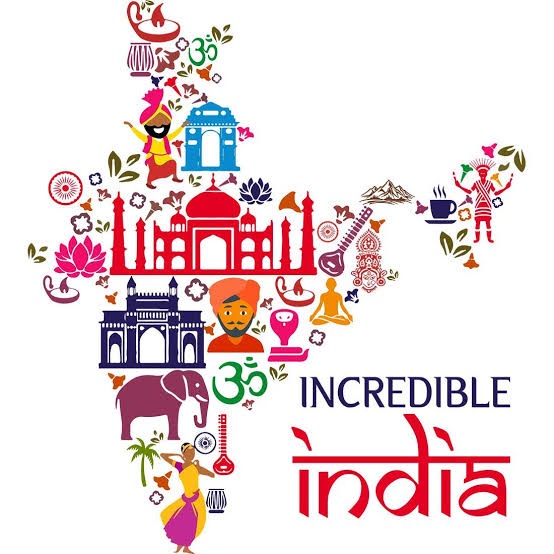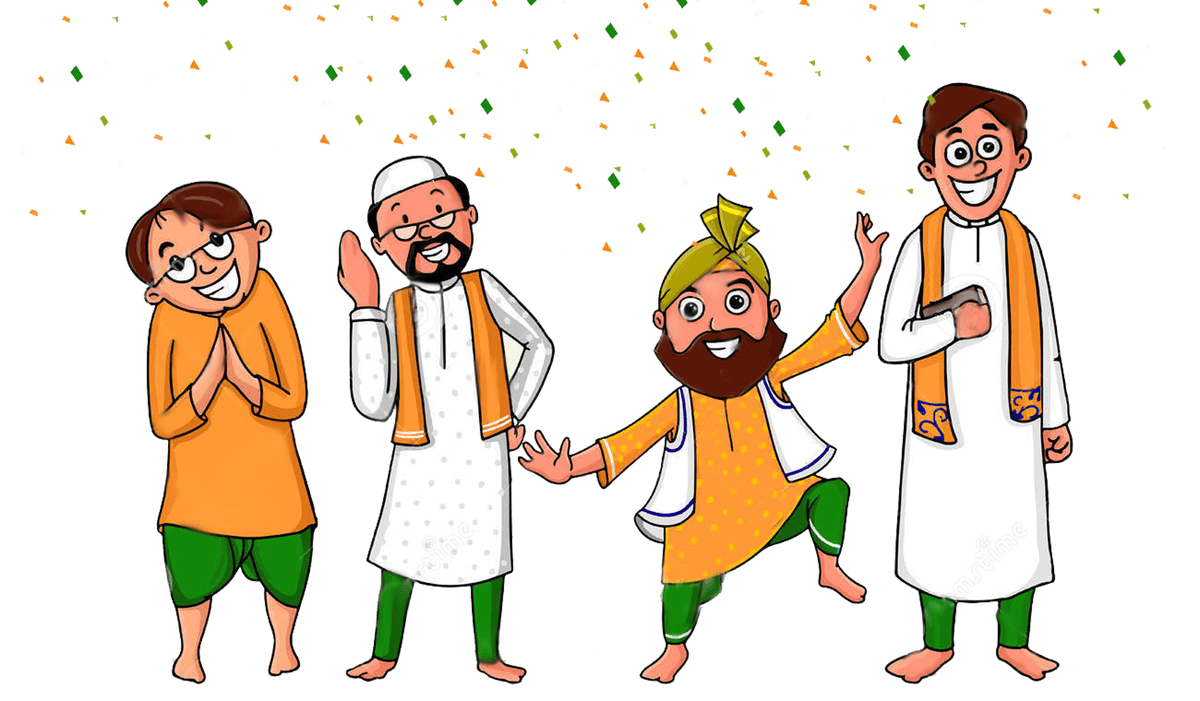The first records of history trace back to the great 5000-year old Indus Valley civilization on the banks of the river Indus. Many planned cities have been excavated at Harappa, Mohenjodaro (now in Pakistan), Lothal in Gujarat and many other cities.
The restless Aryans who came to the subcontinent around 2000 BC, became the inhabitants of the country pushing the Dravidians towards the southern tip of India. Sun worshippers, they settled down to a pastoral life, governed by the politics of kings and emperors. Their own contribution to the civilization was a wisdom born of their travels, their spirit of adventure and their language. Legends of India spread across the continents

The Mauryan dynasty was founded in 323 BC by Chandragupta Maurya and this period is known as the Golden Age. Ashoka, the great monarch was a product of this dynasty. Whilst expanding the boundaries of his empire, he recognised the futility of conquest by war and embraced Buddhism. Later he sent monks with the message of the Buddha to Sri Lanka, Syria, Egypt and Macedonia. Inscriptions listing his ethical principals are found on rocks and pillars throughout India.
Kanishka ushered in the Kushan empire In southern India, the Chola, Pandya and Chera dynasties flourished. The Gupta dynasty strengthened India and trade with Europe began on a major scale. One of the world’s most famous universities at Nalanda opened its doors and the spirit of learning spread across the length and breadth of the country.
The Chalukyas and the Pallavas established dominion in south India. Islam found its way into India in the 8th century AD when Muslim conquerors came to the country and settled down. Subsequently, the Mughals established a mighty empire and the monuments of that period are still virtually intact. Then came the British and for the first time in its history, India was united in a bid to oust foreign dominance and regained her independence to become a democratic nation.
Souvenirs of her glorious past still survive in India. Edicts and stupas from the Mauryan age; the rock temples and mural paintings of Ajanta and Ellora from the Gupta age; the magnificent heritage of Chola and Pallava kings, the great palaces of the Mughals and the traditions of architecture left behind by them, and the imperial extravagance of the Raj which resulted in the railways, posts and telegraph and an organised central administrative machinery.
This history continues to live in India. Religion and culture combine with education to give the Indian a background that other nations envy.

Religions
The majority of the people follow Hinduism with its manifold pantheon of gods. The trinity of principal gods is Brahma the Creator, Vishnu the Preserver and Shiva the Destroyer. When the Indo-Aryans first penetrated India about 2000 BC they met the Dravidians who had already attained a high degree of civilisation. To make any religious headway in the new territory, the invaders had to adopt many of the Dravidian beliefs and weave them into a new body which is now known as the Puranic literature (c.600 BC), while Nature worship – on a very high plane- was represented in the songs and prayers of the Vedas. The river Ganga is held sacred by all and all along her length have sprung up towns to propitiate the river goddess. The holiest of cities is Varanasi, where to bathe in the Ganga is to wash off all earthly sins.
Islam came late to India along with the Moslem invasions. It is a strictly monotheistic religion which professes the fatalistic acceptance of God’s will and which allows no “graven images” to profane its worship. India also has a fair share of mosques. The Jama Masjid in Delhi is one of India’s most magnificent sights.
Buddhism marks the first great revolt against a religion dominated by sacrifices and other forms of priestcraft. Many centuries ago, Lord Buddha preached sermons on the eight-fold path to salvation. Pilgrims come today to retrace the footsteps of the Buddha From Bodhgaya where he attained enlightenment to Sarnath where he preached his first sermon.
Sikhism began life in the 15th century as an offshoot of Hinduism. The founder Guru Nanak (guru means teacher) preached against hypocrisy in religion, but it was the 17th-century leader, Guru Gobind Singh, who forged the Sikhs into a martial community. Sikhs have built gurdwaras in most cities and towns. A sight worth seeing is the Golden Temple at Amritsar.
Christianity came to India with St. Thomas who came to Kerala and converted the people of the Malabar coast into Christians. Roman Catholics owe much to a Jesuit missionary, St. Francis Xavier, who came to India in the wake of the Portuguese in the 16th century. The various Protestant sects are mainly the result of British influence. The best churches are found in Goa, Kerala, Mumbai, Chennai and Kolkatta. A 16th century Jewish synagogue is one of the landmarks of Cochin.
Jainism – The Jains have no use for the supernatural: their beliefs are more purely philosophical than religious. They define “right conduct” by the essential principals of non-violence and total tolerance for other faiths. Jain tirthankaras (sages or perfect souls) are examples – not gods. They are enshrined at many places, some thousand years old. These include Mount Abu, Sravanbelgola, Khajuraho and Palitana.
Zoroastrianism. The Parsees fled their native Persia in the face of Muslim religious persecution and arrived in India in the 7th century. Their holy book, the Zend Avesta, describes the eternal fight between good and evil and man’s duty in this conflict. Parsees worship fire, and Mumbai has numerous fire-temples.
India and her nuances are as infinite as her concepts. She is a village, a meadow, a sleepy town left behind by the advances of time. She is also bustling metropolises, booming factories, and one of the few countries in the world that is almost entirely self-sufficient. Hers is the blue summer sky, the gold drenched fields and snowy winter morns. Hers too the factory whistle, the commuters rush hour and brisk trading in supermarkets.
India represents diversity in all its forms: people, religions, customs and traditions, clothes, dialects and habits. She begins with the highest peaks and descends across mighty fastness and rolling plains to submerge in three seas. Beaches surround her coastal belts and in Rajasthan there is the stillness of the Thar desert. The great seas, a still desert, the might of the Himalayas…..India has all this and more. Backwater canals and tropical forests, rugged hill towns, river estuaries, wooded swamps and glacial meadows. Regions unattainable by road. Places unexplored. The suavity of city dwellers contrasts sharply with aboriginal tribes who still lead their sheltered existence unhindered by the spread of civilisation.
To the Indian, the country is a harmonious whole which he does not question. To the foreigner, the diversity is a puzzling complexity which he seeks to understand.
Geographically India has three main physical divisions, the mountainous north and north-west: the Indo-Gangetic plain: and Peninsular India.
The Himalayan range of mountains with some of the highest peaks like Mt. Everest and Kanchenjunga stretches for 2500 km. from the eastern tip of the country to the western limits of Kashmir and constitutes the most formidable barrier in the world. They cut off India from central Asia. Himalaya means the home of snow and is traditionally described as very ancient with a special place in the religion and folklore of the country. The few accessible passes in the north-east and the north-west were always known to the merchants and travellers who used the overland route for trade with India. Alexander used the same passes in the north-west and later on came other invaders to loot and pillage the rich northern hinterland. Some, like the Mughals came to stay and made India their home.
The Himalayan glaciers feed the mighty rivers that flow through the Indo-Gangetic plain, one of the most productive and thickly populated lowlands in the world. To the south of the Indo-Gangetic plain lies the vast triangle of Peninsula India. Some hill ranges separate the region from the north. The eastern side of the peninsula has a broad coast-line running along the Bay of Bengal while on the opposite side there is a narrower coastal strip along the Arabian sea.
Stretching over 3200 km north to south and 2900 km east to west, India presents extremes of nature and climate. Differences are presented by the freezing heights of the Himalayas in the north and the steamy tropical heat of Kerala in the south or from rain-swept Cherapunji in Assam in the east (which has the distinction of being the wettest part in the world) to that of the rainless tracts of the Thar desert of Rajasthan in the west.
India’s climate can be described as monsoon-tropical – inspite of some local variations like the winter rains in the Northwest.
From March through till May, summer reigns and the weather is really hot. At the beginning of June, the monsoon (rainy) season sets in until the end of September. The clear cold weather arrives and moves gradually eastwards and southwards. It is cool from October to February.
Indian food is a heady multi-course meal for the gourmet with a taste for the exotic – to be eaten crisp and freshly cooked from the hearth, for therein lies the flavour.
The mainstay of India’s food is wheat and rice. Wheat is kneaded into a dough and prepared in a wide range of rotis, parathas, naans and puris (flatbreads). Rice is boiled plain, fried, spiced and served in mouth-watering concoctions. These are eaten with a variety of meat, fish and vegetable dishes in exotic combinations with very surprising results. Barbecued, grilled, curried or fried meats, rich seafare, lentil curries, curd preparations, salads, pickles, chutneys and rotis/rice are the basic foods of an Indian meal.
Ranging from subtle to rich, from bland to fiery, the variations are unending: the elaborate courses of the Kashmiri wazwan, Goa’s hot shellfish curries and vindaloo, delicate flavours of idli (steamed rice cake) and dosa (crisp rice pancake) combined with the spicy lentils and chutneys of the south, the subtlety of paneer, a freshly made cottage cheese and the north Indian speciality – tandoori chicken, cooked in a clay oven. Fish is a feature of Bengali cooking as in Dahi Maach (curried fish in yogurt) and Mailai (curried prawn with coconut). An Indian dinner normally ends with the chewing of paan, an aromatic envelope of green leaf with betelnut, slaked lime and varieties of spices, which is supposed to aid digestion. Besides the main dishes there are also countless irresistible snacks available on every street corner, such as samosas, dosas and vadas.
Although all Hindus are not vegetarians, a wide variety of vegetable dishes are available especially in the South. Raitas (yogurt with grated cucumber and mint) accompany meals. Coconut is a major ingredient of South Indian cooking. Meat dishes are more common in the north, notably Rogan Josh (curried lamb) Malai kofta (spicy meat balls in cream) Tandoori chicken (baked in a clay oven) and the delicious biryani (chicken or lamb in orange flavoured rice).
For deserts, there is a very wide range of milk based sweets, syrup sweets, candies and sundaes, the most popular ones being kulfi, the Indian ice-cream, Rasgullas (cream cheese balls flavoured with rosewater) jelebi (pancakes in syrup) and gulab jamuns (flour ,yogurt and almonds).
Tea is India’s favourite drink and many of the varieties are famous the world over. It will often come ready brewed with milk and sugar unless “tray tea” is specified.
Coffee is increasingly popular. Nimbu pani (fresh lime drink), lassi (iced buttermilk) and coconut milk straight from the nut are cool and refreshing. Soft drinks, bottled mineral water and Western alcoholic drinks are widely available. Indian beer and gin are comparable with the world’s best. Liquor permits are required in some states.